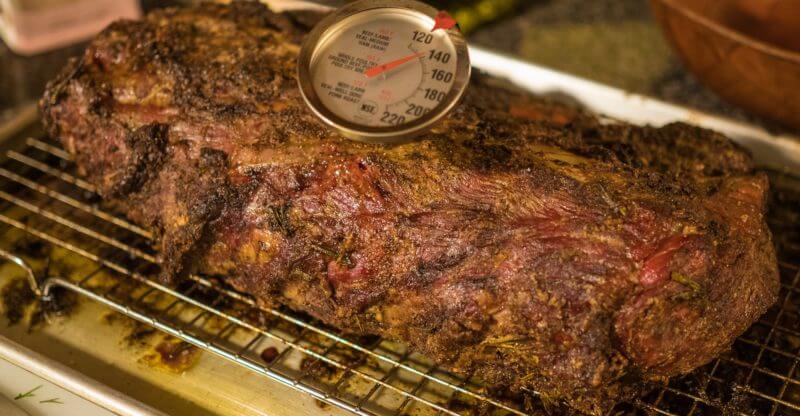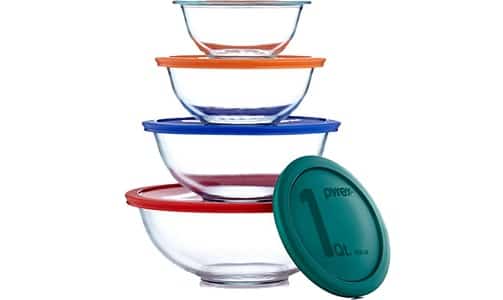Where to put meat thermometer in chicken effortlessly (and 12 other meats!)

The right meat thermometer can ensure food safety and take a great deal of guesswork out of cooking, especially when paired with an efficient roaster oven. However, a thermometer will not do you any good unless you know how to use it properly, and that is dependent on where you insert the meat thermometer in the meat. Here are some guidelines to follow that will ensure you achieve correct results.
Chicken Thermometer Location
Table of Contents
Insert the thermometer into the thickest part of the chicken. When cooking a whole chicken, this would be in the thigh area near the breast. If you are preparing individual drumsticks, breasts, or thighs, insert the probe into the meatiest section of each piece. Never allow the tip of the thermometer to come into contact with any bone. Your meat is done if the temperature reads at least 165 degrees Fahrenheit.
Where to Place Meat Thermometer in Turkey
To check the temperature of a turkey, you will use a process similar to that used for a chicken. As with a chicken, the correct turkey thermometer location is in the thickest part of the bird. This is typically in the crease where the thigh meets the breast. Your turkey is done if it registers 165 degrees Fahrenheit or hotter.
You may be cooking only certain pieces of a turkey. For wings, you should insert the thermometer into the meaty section in or near the crease. For turkey breasts, place the tip into the center of the breast and as far away from the ribs as possible.
Checking Steak and Hamburger Temperature
Insert your meat thermometer through the side of the steak, ensuring it is away from any bone or fat. The desired temperature will vary based upon the degree of doneness you desire. Use the following as a guide:
• 125°F and below indicates a rare steak
• 130°F indicates a medium-rare steak
• 140°F means your steak is medium
• 150°F says your steak is medium well
• 160°F indicates a well done steak.
You can use the same chart to check the doneness of hamburgers. However, when checking hamburgers, place your thermometer as close to the center of each piece of meat as possible.
When grilling burgers and steaks, you should allow the meat to rest for at least five minutes before serving. Doing so will allow more juices to flow, resulting in a moister finished product. Even while resting, the internal temperature of your meat will continue to rise. Accordingly, you should remove your steak or hamburger from the grill when it is five degrees lower than the desired temperature.
Beef Roasts
Check the temperature of a beef roast by inserting the meat thermometer into the thickest part of it. Be sure that the thermometer does not touch any bone in the process. Your roast is completely cooked if it registers at least 160 degrees.
Pork Chops and Roasts
Pork chops and roasts are fully cooked when they are between 145 and 160 degrees Fahrenheit. When checking a roast, place the thermometer into the thickest part of it. Ideally, this will also be near the center of the roast.
For boneless pork chops, insert the probe into the center of each piece. If your pork chops have bones, look for the thickest area that is also primarily muscle with little or no surrounding fat. As always, ensure the tip of your thermometer does not come into contact with any bone.
Ham
Insert a food thermometer into the center of your ham, ensuring that it is at least 145 degrees Fahrenheit. When baking a preheated ham you face even greater odds of bacteria spreading. In that case, you should heat your ham until it has reached 165 degrees Fahrenheit.
Lamb and Mutton
Check lamb and mutton by placing your thermometer into the center of your meat. Lamb chops and mutton are done if they register at least 145 degrees Fahrenheit. Ground lamb on the other hand is not considered fully cooked unless it has an internal temperature of at least 160 degrees Fahrenheit.
Wild Game
To check the temperature of deer, elk, bison, or other wild game, you will use the same principles as with most other types of meat. That involves placing the food thermometer into the thickest section and avoiding any bone or fat. Venison, elk, and bison are considered done when they reach an internal temperature of 160 degrees Fahrenheit.
Using a thermometer to check the temperature of your meat is easy to do when you follow this guide. Keep the above information in mind to ensure your meat dishes are always cooked to perfection.
Conclusion
According to the USDA, you need to make sure your meats are cooked to at least 145 °F for most meats, and 160 °F for ground meats. This is important to avoid bacterial infections like Salmonella disease. Are you still wondering about general kitchen thermometers? Read our conclusive guide about different kitchen thermometers here.
Let us know in the comments section if you prefer your meats to be cooked in a specific temperature!


